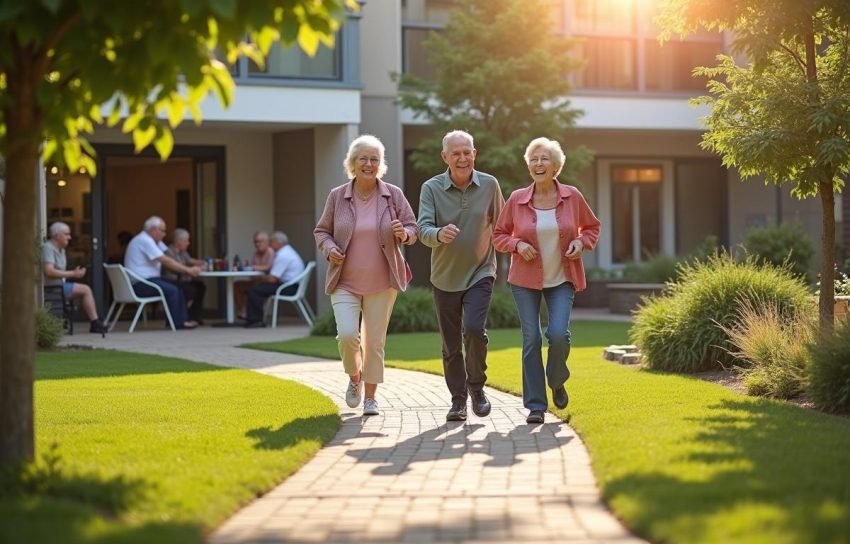Finding the Right Senior Living Fit Without the Stress

Finding the right environment for senior living can be a daunting process. The key is to start by looking at personal preferences and daily habits well before any urgency arises. This proactive approach allows you the time and clarity to evaluate different retirement communities or assisted living options. In the following sections, you’ll find practical tips to make this transition easier while supporting healthy aging and a fulfilling lifestyle.
Contents
- 1 Identifying Personal Goals and Preferences
- 2 Exploring Options for Active Seniors
- 3 Prioritizing Retirement Fitness and Healthy Aging
- 4 Balancing Independent Living and Support Services
- 5 Emphasizing Nutrition for Active Seniors
- 6 Maintaining Mobility and Mental Flexibility
- 7 Evaluating Budget and Lifestyle Goals
- 8 Fostering a Thriving Future
Identifying Personal Goals and Preferences
Before narrowing down your choices, think about what truly matters to you or your family member. Perhaps staying close to grandchildren is a priority, or maybe having quick access to senior fitness programs is a top concern. Consider your daily routines, hobbies, physical abilities, and long-term plans. Location is also a crucial consideration, so if you reside in South Carolina, exploring Greenville independent living can help you find communities that balance convenience with access to local amenities. Assessing these points will help you find a living arrangement that aligns with personal values and offers room for growth and enjoyment.
Considering Physical and Emotional Well-Being
Taking a close look at physical health and emotional needs goes a long way toward finding the perfect place to call home. Look for centers that provide exercise for seniors, group exercises for seniors, or specialized classes like senior strength training. These activities not only boost mobility for seniors but also foster social connections that can brighten each day. Meanwhile, a supportive environment can greatly help with mental health for elderly individuals, keeping spirits high and minds engaged.
Exploring Options for Active Seniors
Some older adults thrive in communities designed with an active lifestyle in mind, such as independent living facilities or retirement homes that cater to seniors ready for adventure. These setups frequently include walking trails, pool facilities, and other amenities that promote physical activity for seniors who enjoy outdoor leisure. They often encourage senior social activities that go beyond scheduled events, making it easier to connect with neighbors who share similar interests. If you still want to maintain a sense of independence, focusing on places that champion active aging and elderly wellness can be a key factor in staying happy and healthy.
Looking at Senior Wellness Communities
A senior wellness community might offer various on-site amenities such as senior exercise classes, art studios, cooking workshops, or day trips that bring people together. When choosing one of these establishments, pay attention to their approach to elderly care, including how they incorporate nutrition for seniors into daily meals. Well-planned dining options can address senior nutrition needs, ensuring a balanced diet and steady energy levels throughout the day. Social engagement and balanced meal plans can promote a sense of purpose for residents who want an environment where they remain active and vital.
Prioritizing Retirement Fitness and Healthy Aging
When it comes to retirement fitness, there’s more to consider than just a regular workout schedule. Many senior living communities offer dedicated fitness for older adults, including geriatric exercise programs that cater to varying ability levels. Some also feature specialized areas for balance exercises for seniors, aiming to reduce the risk of falls and support continued mobility. This commitment to senior health activities allows residents to maintain independence while boosting confidence in day-to-day tasks.
Tailoring Senior Fitness Programs
It’s essential to find programs that address individual needs, whether it’s low-impact water aerobics or more vigorous workouts. Group exercises for seniors can foster motivation through camaraderie, while personal trainers or physiotherapists might provide one-on-one guidance for those needing tailored instruction. Every person’s body and comfort level differ, so choose a community that offers a range of senior fitness programs. With so many options, you can discover a consistent exercise routine that feels safe, fun, and effective for long-term wellness.
Balancing Independent Living and Support Services
Independent living doesn’t have to mean sacrificing assistance when you need it most. Many senior living communities now provide flexible packages, allowing residents to pick and choose services that suit their current stage of life. These can include housekeeping, laundry, transportation, and help with meal planning, all aimed at preserving an active lifestyle without imposing unnecessary burdens. By blending independence with strategic support, residents can thrive in a comfortable space while preserving their sense of autonomy.
Aging in Place vs. Moving to a New Community
Some people lean toward aging in place, modifying their homes to accommodate changing physical needs. Others opt for senior care facilities that blend social interaction with professional support. Each option comes with its own advantages and challenges. Deciding whether to adapt a current home for elderly wellness or move into a new environment can depend on budget considerations, required medical care, and personal preferences for security and companionship.
Emphasizing Nutrition for Active Seniors
Nutrition for active seniors is critical to preserve strength, energy, and overall health. A balanced diet with fresh fruits, vegetables, lean proteins, and whole grains helps manage weight, blood pressure, and cholesterol. In many senior living communities, there is a focus on healthy meal planning, ensuring residents have access to nutrient-rich food selections that encourage wellness for seniors. Whether you enjoy dining with neighbors in a communal setting or prefer cooking at home, consistent and healthy eating habits can keep you feeling your best.
Senior Social Activities Around Mealtime
Many older adults are delighted to discover that communal dining offers more than a tasty meal these events can foster meaningful connections. Sharing a table gives everyone a chance to laugh, share stories, and plan future get-togethers. These mealtime gatherings also spark opportunities for group celebrations, special holiday feasts, or other events that accommodate various cultural or dietary preferences. By turning meals into social occasions, seniors stay emotionally engaged and look forward to enjoyable moments each day.
Maintaining Mobility and Mental Flexibility
Staying physically active often goes hand in hand with emotional stability, especially during the golden years. Routine physical activity for seniors doesn’t have to be strenuous; short walks, gentle yoga sessions, or simple balance exercises can make a significant difference over time. Regular movement preserves muscle tone, enhances cardiovascular health, and reduces the risk of injuries due to falls. Meanwhile, mentally engaging pursuits like puzzles, trivia nights, or art classes can encourage cognitive sharpness and sustain a sense of curiosity.
Encouraging Social Connection
Building friendships and connections in a new environment can ward off loneliness and support overall mental health for elderly adults. Many senior living communities organize outings, day trips, and hobby-based gatherings that help neighbors bond and create lasting memories. Even smaller moments, such as a morning coffee meetup or a casual chat in the common lounge, can cultivate familiar faces and friendships. Purposeful social connections remind people that they’re not alone, especially during life transitions.
Evaluating Budget and Lifestyle Goals
Financial considerations play a pivotal role in determining the best living option. Some families have resources to afford upscale senior living communities with perks like private gardens, swimming pools, and gourmet dining. Others might prefer more modest settings that still offer essential services like senior exercise classes and on-site healthcare. Balancing your budget with a vibrant senior lifestyle can guide you toward the perfect place, ensuring you invest in amenities that genuinely matter.
Tips for a Smooth Transition
Give yourself time to explore different options before committing to a new residence. Taking tours, looking at sample menus, and speaking with staff can clarify whether a place aligns with your priorities. It’s also helpful to talk to current residents about their experiences. Their firsthand insights can highlight both the benefits and any potential drawbacks, allowing you to make a confident decision in selecting the right environment for your needs.
Fostering a Thriving Future
Making the leap into a new setting can feel easier and less stressful when you know what you want from life during these years. An environment that promotes mobility for seniors, balanced meals, and ample social engagement will help you live each day with confidence. Seeking spaces that offer geriatric exercise options, senior health initiatives, and a supportive network of neighbors can keep you mentally sharp and physically strong. Ultimately, you’ll have a space where new friendships blossom and you can continue pursuing meaningful interests.
Staying focused on your goals, discussing concerns with loved ones, and trying out activities like organizational tours or trial days can reveal which setup will best support the life you envision. Whether you decide on a senior wellness community or prefer a quieter home on the outskirts of town, picking a spot that balances independence, comfort, and care can truly impact your overall sense of well-being. The journey toward a successful senior living arrangement might require time, but being patient and intentional can help you touch down in the perfect environment for continued growth and joy.



